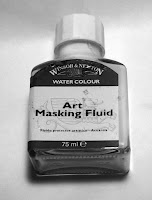Resist fluid is a favorite of mine that works
well with fluid acrylics.
Here's a finished example, below, and I'll provide the steps (and some pointers) below that!
 |
| After the latex was removed, I painted parts of a few exposed lines. |
Resist fluid makes an exciting addition to any
painter’s resources.
I didn’t have a Fineline Resist Pen at the time, so I applied lines and dots with a painting knife. Always apply this product to dry paper! The latex rubbed right off my knife when I was finished.
Other application tools you might use include wooden skewers, toothpicks, old (bad) brushes, even dip pens. Most resist fluid doesn’t thin with water, but you could try ammonia.
If you make a mistake, just let the masked line dry and remove from the paper.
ART TIPS: Don’t try drying the masking fluid design with a hot hair dryer! (But don’t leave the fluid on absorbent paper for a very long time. Also, masking fluid becomes gummy if you leave the cap off too long.
When my mask was dry, I painted with watercolors, although fluid acrylics are fine. (Granulating medium made the gray areas more interesting.)
You MUST let your painting dry well before removing the masking fluid! The latex can be removed with a rubber cement pick-up tool, but I just rub a finger over the masked lines and shapes.
I wanted to color some of the white lines,
so I used blue at right and left edges.
But do leave some white, darn it!
The original white paper will
make your painting sparkle.
THANKS FOR VIEWING THIS POST!



























I love the look...Thanks for sharing you discovery!
ReplyDeleteI always read the comments, and yours are frequent enough that I feel we are true cyber-friends! Thanks, Sue.
DeletePaula